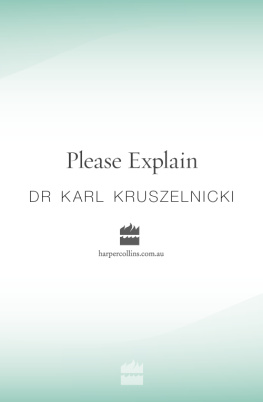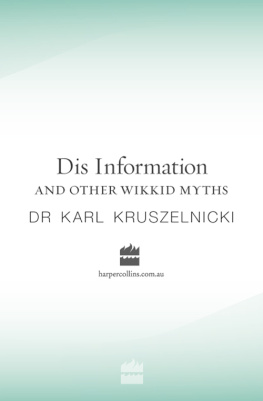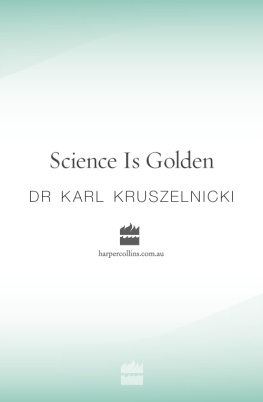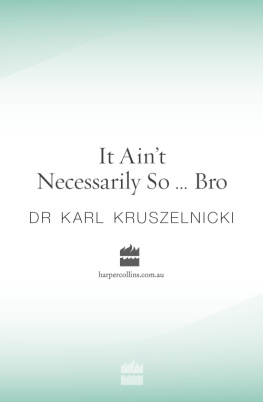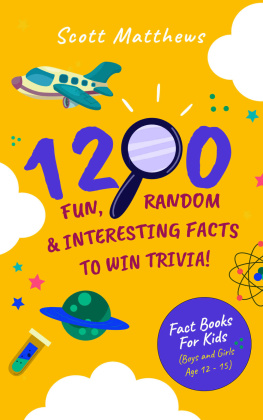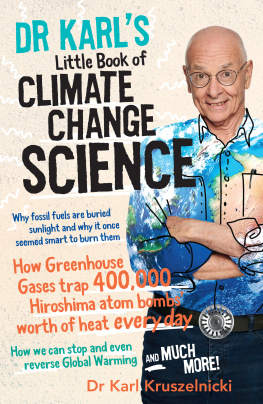My teenage daughter and her friends were recently talking about negative kilojoules. They were curious about whether eating celery would make you lightersupposedly because digesting celery requires more energy than is actually present in the celery. (As an aside, my teenage son would never have given negative kilojoules a thought in his whole life. Is this a generic boygirl difference?) So I had to check out this negative kilojoules theory.
Even though I trained as a medical doctor, the lectures on Nutrition came to a grand total of only eight hours over the whole course. And because nutrition is a huge topic, I knew that that eight hours wouldnt cut it. So I consulted the experts, the nutritionists who spend years studying this enormous body of knowledge. They told me that no-one had ever done an experiment where people were fed nothing but celery. This is partly because the volunteers would soon become ill on a diet totally lacking in proteins or fats and partly because celery has so few kilojoules that any measurements would be difficult to calculate.
Negative kilojoules
Celery is about 95% water, 2.2% digestible carbohydrates and 1.8% indigestible carbohydrates, as well as insignificant amounts of protein and fat.
BUT there are a small number of kilojoules found in celerynot manybut there are some!

The BMR is a measure of the amount of energy needed to keep you alive when you are resting, in a fasted state, lightly clothed and in an environment with a comfortable temperature.
Basal Metabolic Rate101
One way to get to the bottom of this negative kilojoules story is to look at the Basal Metabolic Rate (BMR)a measure of the amount of energy needed to keep you alive when you are resting, in a fasted state, lightly clothed, and in an environment with a comfortable temperature.
Technically, the Basal Metabolic Rate is a measurement of how many millilitres of oxygen you breathe in for every gram of body weight per hour. At rest, human beings typically breathe in about 0.3 ml of oxygen per gram of body weight per hour. Nutritionists measure the BMR by putting a volunteer in an airtight box and measuring how much oxygen they burn up and how much carbon dioxide they generate. These changes in oxygen and carbon dioxide are easy to measure when you consume a huge meal of steak and lots of potatoesand almost impossible to measure when you have a small meal of a few sticks of celery.
About 70% of your total daily energy expenditure is spent in keeping your organs running (e.g. liver, skeletal muscle, brain, kidneys and heart)the BMR, while another 10% comes as a side effect of burning up your food. The remaining 20% comes from physical activity. You can see how, if you increase your exercise just a little and maintain the same food intake, you can lose weight. For example, walking uses about 2000 kJ per hour.
Basal Metabolic Rate102
However most of us dont think in terms of O2ml/gm/hrwe think in kilojoules.
The average man uses about 11 000 kJ per day, while women use around 8000. Of course, this will vary according to your weight, age, gender, coffee habit, exercise program, genes that your parents gave you, height, surface area, muscle massand yes, how much you eat.
Back in 1918, J. Arthur Harris and Francis G. Benedict published their paper A Biometric Study of Human Basal Metabolism. They measured the BMRs for 136 men and 103 women and then did a partial correlation coefficient analysis for any factors that might have an effect on BMRa big task in the days before electronic calculators and computers. The equationsthe original century-old ones for the total heat produced in 24 hoursare still a reasonable approximation:
Men, H = 66.4730 + (13.7516 x W) + (5.0033 x S)(6.7550 x A), Women, H = 655.0955 + (9.5634 x W) + (1.8496 x S)(4.6756 x A),
where H is the total amount of heat produced/energy burnt in 24 hours in kilocalories, W = weight in kilograms, S = height in centimetres, and A = age in years. To convert kilocalories to kilojoules, multiply by 4.2. (According to current wisdom in the book trade, each equation in a book reduces the sales by 50%. Thats why Ive cleverly hidden these equations deep inside the chapter and bunched them up so that you can skim right over them and ignore them.)
Food Tax Overview
Surprisingly, just to digest an average meal, human beings increase their BMR by 50%but only for about four hours. In other words, it costs energy to digest the meal. (This might be the basis of the negative energy in celery myth.) Nutritionists call this extra energy the Thermic Effecta kind of Energy Tax. It is also called the SDA (Specific Dynamic Action)but whatever you call it, it takes energy to digest food.
The question ishow much of the energy in the food is needed to digest it? To answer this, you need to know what your body does to get the energy out of the food that you eat.
Food Tax Breakdown
If you have ever eaten a tough steak, you might think that a lot of the energy that it takes to get the nutrition out of your food comes from chewing. But no, chewing the food takes only 12% of the total energy in the food. The vast majority of the extra energy needed to digest the food is burnt in the gut.
Ultra-marathon Humans
The sport called the ultra-marathon can last up to six days. And the athletes taking part might not beat the Snake Kings of BMR for the highest BMR title, but they do amazing feats. An article in the journal Nature reported that the athletes Trek 125 kilometres, and cycle 250 more. Kayak 131, rappel through canyons for another 97, and swim 13 in churning whitewater. Throw in some horseback riding and rock climbing; spread it all over six days in the blistering Utah heat; and never stop to sleep.
One of the biggest of these events, the Primal Quest Expedition Adventure Race, has teams of four athletes, racing across some 700 km of very difficult terrain. The winning team gets US$250 000 in prize money.
For some unknown reason, these athletes reach their ultra-marathon peak in their mid-30samazingly late in life for such a demanding sport. One theory says (with good evidence) that it helps a lot to get the right genes from your parents. Another theory says (also with good evidence) that the brain of a good ultra-marathoner is heavily involved, for example, in coordinating all the different biochemistries from the overworked lungs, legs and other parts of the body.
In one day, the athletes burn up 84 000 kJ of energyabout 10 times the resting BMR of an average athlete. Its very difficult to eat this much.

About half of this energy is used in three stages. Some of the energy activates the muscles of your gut to mash up your food and push it along the 10-m length of your gut. This helps break down the food into small blobs ranging in size from a fingertip to the head of a matchstick. More of the energy is used to make special chemicals (enzymes) which further break the food down from little blobs into individual molecules. And in the third stage, more energy is used to pump these tiny molecules across cell membranes and into the cells that form the lining of your gut.

